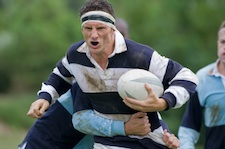Get in shape for the 6 nations
How do you get in shape for the Six Nations? If you are a couch potato, it requires nothing more strenuous than ordering the beers and snacks and getting your mates round - however, for professional rugby players, there's a little more work required!
 Rugby is one of the fastest moving, hardest hitting sports in the world, and the training demands are huge. One of its attractions as a sport is that with its variety of positions there's room for almost everyone - from heavyweight forwards through to speedy wingers. From a training point of view that creates great demands on trainers and coaches.
Rugby is one of the fastest moving, hardest hitting sports in the world, and the training demands are huge. One of its attractions as a sport is that with its variety of positions there's room for almost everyone - from heavyweight forwards through to speedy wingers. From a training point of view that creates great demands on trainers and coaches.
Training for elite rugby players starts with pre-season workouts. This is the only part of the program where all players are likely to work together - the first two weeks of pre-season training are very general, but after that training will be broken down into different program for each positions, and indeed for each individual.
As with all pro sports, training is periodised (planned) across the whole year. This will usually be in a series of 4 to 6-week blocks, taking account of when matches are played, with built in rest periods. The focus of each period may be different, for example increasing muscle mass or reducing body fat.
To keep track of the effectiveness of the workouts, coaches will conduct regular tests - this allows them to address different areas that will affect a player's performance, such as strength, power, speed, and endurance.
Tests will include sprints (10 meters, 40 meters), longer runs, strength tests (squats, bench), and also tests that record the speed of moving a certain weight.
So what does a typical day look like for an international rugby player? The day would start early for those players who need to reduce body fat levels, with a pre-breakfast fat-burning session of cardiovascular training.
The main training session typically starts with some stability and rehab type work, often incorporating Pilates type movements. After a warm up it's into the gym, where players will work not only on pure strength, but also on plyometrics (explosive movements - jumps etc), and power.
Strength work is followed by some light aerobic work to cool down, and any hot/cold treatment that might be needed for those with minor injuries.
For most of us that would sound like more than enough, but for a pro, there's lots more to come! After lunch (low fat and very healthy!) players are encouraged to relax, play games, even take a nap before the afternoon sessions.
After lunch players will work on speed or endurance, depending on the time of year - they will be split into groups according to position, usually forwards, backs and half-backs, and will work with dedicated sprint or endurance coaches.
Finally they will work on game skills, from ball handling to scrummaging, rucks and mauls to line-outs. The day will end with another cool down and some flexibility work, then dinner.
There are typically two rest days per week - usually Wednesdays and Sundays - then the whole cycle starts again! So sit back, open the beer, and let the games begin!